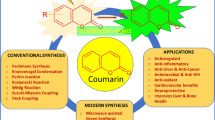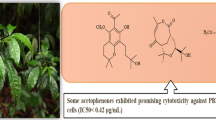Abstract
Damnacanthal and nordamnacanthal, two naturally occurring 9,10-anthraquinones, and their analogues were synthesized. Cytotoxic activity against five cancer cell lines was evaluated using MTT assay. 2-Bromomethyl-1,3-dimethoxyanthraquinone was found to display the highest activity against all cell lines with IC50 range of 2–8 μM. Structure–activity relationship (SAR) assessment was considered to rationalise the cytotoxic effect. Bromomethyl group at position C-2 of the anthraquinone was found to be important in exerting cytotoxic activity of this class of compounds. The presence of the flanking methoxyl or hydroxyl groups at C-1 and C-3 also contributes to this activity. Finally, the antioxidant effect of these compounds was evaluated. MTT assay was used to measure the cytotoxicity against different cancer cell lines. Antioxidant activity was measured by FTC and TBA methods. Only two anthraquinones, damnacanthal and nordamnacanthal, were found to be antioxidative.



Similar content being viewed by others
References
Ali AM, Ismail NH, Mackeen MM, Yazan LS, Mohamed SM, Ho ASH, Lajis NH (2000) Antiviral, cyototoxic and antimicrobial activities of anthraquinones isolated from the roots of Morinda elliptica. Pharm Biol 38(4):298–301
Cambie RC, Rutledge PS, Woodgate PD (1992) Synthetic anthracyclines from anthraquinones. Aust J Chem 45:483–512
Cardia MC, Begala M, DeLogu A, Maccioni E (2001) Synthesis and biological evaluation of some differently substituted 9,10-anthracenediones. Il Farmaco 56(8):549–554
Chang P, Lee KH, Shingu T, Hirayama T, Hall IH (1982) Antitumor agents. 50. Morindaparvin-A, a new antileukemic anthraquinone, and alizarin-1-methyl ether from Morinda parvifolia, and the antileukemic activity of the related derivatives. J Nat Prod 45(2):206–210
Enger TA, Iyenrar R (1998) Lewis acid-directed reactions of quinones with styrenyl systems: the case of 2-methoxy-3-methyl-1,4-benzoquinone. J Org Chem 63:1929–1934
Huang SS, Yeh SF, Hong CY (1995) Effect of anthraquinone derivatives on lipid peroxidation in rat heart mitochondria: structure-activity relationship. J Nat Prod 58(9):1365–1371
Ismail NH, Ali AM, Aimi N, Kitajima M, Takayama H, Lajis NH (1997) Anthraquinones from Morinda elliptica. Phytochemistry 45(8):1723–1725
Jin G-Z, You Y-J, Ahn B-Z (2001) Esters of 2-(1-hydroxyalkyl)-1,4-dihydroxy-9,10-anthraquinones with melphalan as multifunctional anticancer agents. Bioorg Med Chem Lett 11(11):1473–1476
Johnson MG, Kiyokawa H, Tani S, Koyama J, Morris-Natschke SL, Mauger A, Bowers-Daines MM, Lange BC, Lee KH (1997) Antitumor agents-CLXVII. Synthesis and structure-activity correlations of the cytotoxic anthraquinone 1,4-bis-(2,3-epoxypropylamino)-9,10-anthracenedione, and of related compounds. Bioorg Med Chem 5(8):1469–1479
Kikuzaki H, Nakatani N (1993) Antioxidant effect of some ginger constituents. J Food Sci 58:1407–1410
Mackeen MM, Ali AM, Lajis NH, Kawazu K, Hassan Z, Amran M, Habsah M, Mooi LY, Mohamed SM (2000) Antimicrobial, antioxidant, antitumour-promoting and cytotoxic activities of different plant part extracts of Garcinia atroviridis griff. ex T. anders. J Ethnopharmacol 72(3):395–402
Mishra G, Gupta N (1982) Chemical investigation of roots of Morinda tinctoria Roxb. J Inst Chem 54(1):22–25
Mosmann T (1983) Rapid colorimetric assay for cellular growth and survival: application to proliferation and cytotoxic assays. J Immunol Methods 65:55–63
Roberts JL, Rutledge PS, Trebilcock MJ (1997) Experiments directed towards the synthesis of anthracyclinones. I Synthesis of 2-formylmethoxyanthraquinones. Aust J Chem 30:1553–1560
Tetko IV, Gasteiger J, Todeschini R, Mauri A, Livingstone D, Ertl P, Palyulin VA, Radchenko EV, Zefirov NS, Makarenko AS, Tanchuk VY, Prokopenko VV (2005) Virtual computational chemistry laboratory: design and description. J Comput Aided Mol Des 19(6):453–463
Veber DF, Johnson SR, Cheng HY, Smith BR, Ward KW, Kopple KD (2002) Molecular properties that influence the oral bioavailability of drug candidates. J Med Chem 45(12):2615–2623
Wei BL, Wu SH, Chung MI, Won SJ, Lin CN (2000) Synthesis and cytotoxic effect of 1,3-dihydroxy-9,10-anthraquinone derivatives. Eur J Med Chem 35(12):1089–1098
Werner W, Grafe U, Ihn W, Trrsselt D, Winter S, Paulus E (1997) Synthesis of tolypocladin and isotolypocladin. Tetrahedron 53(1):109–118
Yen G-C, Duh P-D, Chuang D-Y (2000) Antioxidant activity of anthraquinones and anthrone. Food Chem 70(4):437–441
Zacharie B, Attardo G, Barriault N, Penney C (1997) Regioselective synthesis of 6-substituted 2-hydroxybenzaldehyde: efficient synthesis of the immunomodulator tucaresol and related analogues. J Chem Soc Perkin Trans 1:2925–2929
Zagotto G, Supino R, Favini E, Moro S, Palumbo M (2000) New 1,4-anthracene-9,10-dione derivatives as potential anticancer agents. Farmaco 55(1):1–5
Zhang X, Fox BW, Hadfield JA (1996) Preparation of naturally occurring anthraquinones. Synth Comm 26(1):49–62
Zhao YH, Abraham MH, Le J, Hersey A, Luscombe CN, Beck G, Sherborne B, Cooper I (2002) Rate-limited steps of human oral absorption and QSAR studies. Pharm Res 19(10):1446–1457
Acknowledgments
The authors wish to thank the University Putra Malaysia and the Ministry of Science, Technology and the Environment for the fund provided under the Intensified Research in Priority Areas (IRPA) programme. The corresponding author (NHL) also thanks the Scientific Chairs Unit, Taibah University for its supports.
Author information
Authors and Affiliations
Corresponding author
Rights and permissions
About this article
Cite this article
Saha, K., Lam, K.W., Abas, F. et al. Synthesis of damnacanthal, a naturally occurring 9,10-anthraquinone and its analogues, and its biological evaluation against five cancer cell lines. Med Chem Res 22, 2093–2104 (2013). https://doi.org/10.1007/s00044-012-0197-5
Received:
Accepted:
Published:
Issue Date:
DOI: https://doi.org/10.1007/s00044-012-0197-5




